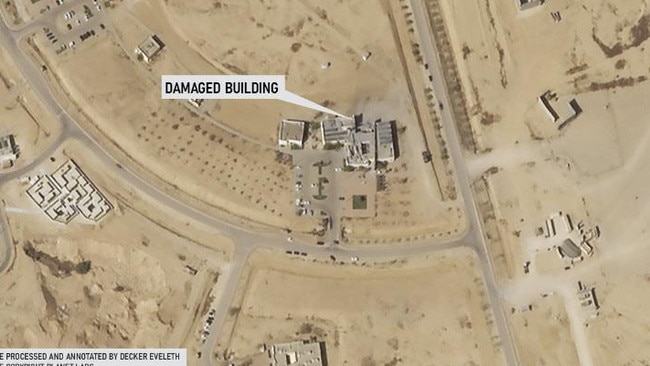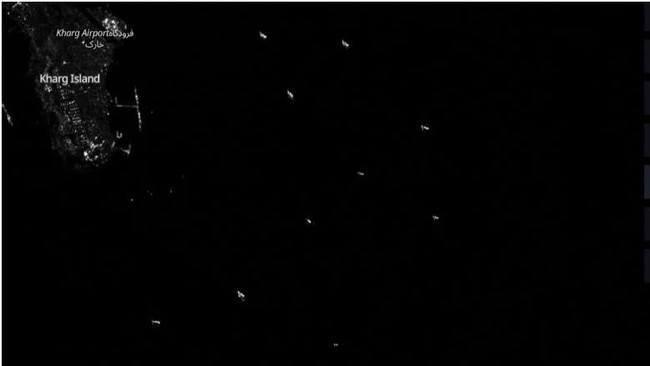Satellite images that have the world on edge
As the world watches the Middle East with bated breath, concerning new satellite images show what could happen next.
World
Don't miss out on the headlines from World. Followed categories will be added to My News.
Satellite photos reveal at least 30 Iranian ballistic missiles struck within the perimeter of Israel’s most important military air base. Now fears are growing Israel wants to retaliate by destroying Iran’s biggest commercial oil facility.
The Iranian attack Tuesday targeted Israeli military bases and the headquarters of its Mossad international espionage agency.
Tehran says it launched 180 ballistic missiles in retaliation for Israel’s assassination on Iranian soil of Hamas political leader Ismail Haniyeh, who was a guest of the state attending the inauguration of its new president.
Many of the missiles were intercepted by Israeli and US air defences.
Amid tight Israeli censorship, the extent of Iran’s success is only now becoming apparent.
But clues about how Israel’s Prime Minister Benjamin Netanyahu plans to respond are also emerging.


Earlier this week, US President Joe Biden urged Israel not to respond by hitting Iran’s controversial nuclear power and refining facilities, warning this would almost inevitably lead to further escalation.
“Iran made a big mistake tonight, and it will pay for it,” Netanyahu said in a video released the morning after the attack.
“The regime in Iran does not understand our determination to defend ourselves and our determination to retaliate against our enemies. They will understand. We will stand by the rule we established: whoever attacks us, we will attack him.”
Israeli media is now reporting anonymous officials as saying it is now considering an attack on Iran’s oil facilities first, saving its nuclear industry as retaliation for any further Iranian retaliation.
This has led to widespread speculation that Iran’s primary oil storage and shipping terminal, Kharg Island, will be the target.
Iran certainly believes so.

International analysts have noticed most of the tankers stationed there have put to sea. As has most of Iran’s small navy.
Oil prices surged 5 per cent Thursday after Biden was asked by US media if he supported such an attack: “We’re discussing that. I think that would be a little … anyway.”
Analysts add an actual attack would result in another immediate 5 per cent spike, with follow-up events determining its short term future.
Yesterday, Biden walked back his implied criticism. “Look, the Israelis have not concluded what they’re going to do in terms of a strike. That’s under discussion,” he said. “I’m assuming when they make a decision on how they’re going to respond, we will then have a discussion”.
Deep impact
Israel’s Nevatim Air Base is the home base of its most capable combat aircraft – the F-35 Stealth Fighter.
It was at the heart of Iran’s October 1 missile assault, which also included the Tel Nof air base and Mossad HQ.
Israel’s Defence Force has not been forthcoming about what damage was sustained.
So Open Source Intelligence (OSINT) analysts have been scouring commercially available satellite imagery ever since to determine just how successful the attack was.
🇮🇷🚀🇮🇱 Geolocation confirms that Iranian hits pounded the Nevatim airbase.
— Theurgy (@eTheurgy) October 2, 2024
Reviewing the footage, you can see slower projectiles mixed in with the supersonic ones, with the supersonic projectiles hitting the important targets.
✨@warcabinet_pic.twitter.com/aRmomVtijb
“it seems the strike on Mossad headquarters in Glilot was the least successful. We only saw two impacts, and the one impact that landed even remotely near the headquarters building did so about 520 meters away from the building itself,” says Center for Naval Analysis analyst Decker Eveleth.
“The strikes at Tel Nof and Nevatim seem to have been much more successful. We don’t have imagery of Tel Nof yet, but there is social media footage of warheads raining down on the base, and some seemed to have caused secondary explosions, which is good evidence that they likely hit something worth hitting.”
Cloud cover during the week has reportedly obscured much of Tel Nof Air Base from prying satellite eyes.
But Nevatim has had more clear air.
Our first count is that 32 missiles struck Nevatim Air Base (pins) -- although three impact points are obscured by clouds in the 50 cm Skysat and had to be made with 3 m Dove images (white pins). @DuitsmanMS@sam_lair@dex_eve@JamesMartinCNSpic.twitter.com/AKxE8g41Vm
— Dr. Jeffrey Lewis (@ArmsControlWonk) October 3, 2024
Eveleth says some 33 likely impact craters have been identified within the secure compound.
“It may shake down that Iran hit the base with something like 40 warheads,” he added.
Unlike its first missile attack in April, Iran this time added its more modern – and accurate – Fattah and Kheibar Shekan missiles. These use solid rocket fuel and have manoeuvring warheads.
One other point I'd make here - we don't have imagery of Tel Nof yet, but we did see secondary explosions on social media. And if they can get through at Tel Nof, well...Israel's ballistic missile base is only 15 km away. pic.twitter.com/SCmwNSYqqe
— Decker Eveleth (@dex_eve) October 3, 2024
“So what did they hit? Well, not much,” Eveleth concludes.
Most appear to have fallen into the open fields of the air base.
But at least one direct hit was scored on a hangar. And several support buildings appear to have been collapsed.
Two impact craters are also apparent on the taxiways alongside hardened F-35 shelters. One may have even resisted a direct impact.
“(This) should demonstrate that the lack of serious damage to the facilities here at Nevatim was as much luck as it was due to the relative inaccuracy of Iranian missiles,” he adds.

“It could either be that the warhead that landed here was a dud and didn’t explode, or Israeli aircraft shelter construction techniques contain explosions really well.”
Easy target
Satellite images also reveal Iran is taking the threat on its oil terminal – the epicentre of 90 per cent of its exports – seriously.
Kharg Island is 24km off Iran’s northwest coast. Most of its piers are empty, with images revealing numerous large oil tankers appearing to scatter in different directions.
solid work @Battlefront_Net! Some of them didn't go far... Haven't had time for a full analysis but still a sitting duck, just sitting in a new spot pic.twitter.com/pgl6n0BOP2
— MT Anderson (@MT_Anderson) October 4, 2024
“The National Iranian Tanker Company (NITC) appears to be fearing an imminent attack by Israel. Their empty VLCC supertankers vacated the country’s largest oil terminal, Kharg Island, yesterday,” TankerTrackers.com posted to social media Friday.
“Please note that crude oil loadings continue, but all of the extra vacant shipping capacity has been removed from the anchorage of Kharg Island. This is the first time we see anything like this since the 2018 sanctions round,” the tanker tracking service added.
@MT_Anderson
— Intelschizo (@Schizointel) October 4, 2024
Iranian navy departed from port same time frame as the supertankers from Karg as reported by @TankerTrackers.
Shahid Soleimani class missile corvette, IRIS Makran, Moudge-class and Alvand Class Frigates. (Dena already was on deployment to Gulf of Aden)
Might… pic.twitter.com/jcnTENPAjZ
At the same time, the global oil benchmark Brent crude rose to $US78 a barrel.
It’s the first dramatic price shift since the Israel-Gaza-Lebanon war began.
“Crude remains cheaper than it was one year (or even two years) ago,” says Foreign Policy analyst Keith Johnson.
Picture from yesterday got the inventory at Kharg island, Iran increased by 2.6 mbbls @ 22.2 mbbls vs 25th of Sep estimated @ 19.6 mbbls
— Kim BENNI (@BenniKim) October 4, 2024
This is not what you would expect after @TankerTrackers reported that the dark fleet VLCCs were leaving.
It doesn't really make sense for… https://t.co/lG7ieScukHpic.twitter.com/3USKwGtKGV
“And that insouciance continued despite a relentless campaign by Iran-backed Houthi militants in Yemen, who have all but closed the Red Sea to commercial shipping and even attacked several oil tankers.”
But such an attack could bring an international backlash down on Prime Minister Netanyahu.
“An all-out strike on Kharg Island would poleax Iran’s ability to earn much-needed revenue … but at the cost of spiking oil (and gasoline) prices for everybody else, including Americans just weeks away from a pivotal election,” Johnson adds.
Iran’s oil exports are the subject of international sanctions.
But its tankers – often operating without safety navigation beacons active – continue to deliver significant supplies to China. Reducing Iran’s deliveries would compel China to source oil elsewhere – driving up costs.
An alternative target could be Iran’s largest oil refinery in Abadan, Khuzestan Province.
This produces diesel and petrol for Iran’s local market. And shortages and price surges have prompted widespread protests in the past. In 2019, more than 200 people died in riots following moves to cut fuel subsidies that resulted in sharp increases at the bowser.
Originally published as Satellite images that have the world on edge


